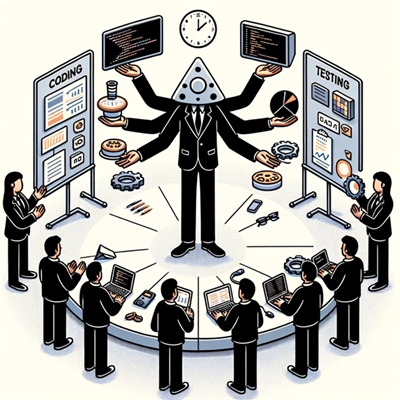While uncertainties are always challenging organizations’ capacity to deliver value, the future is an amazing place to be and it promises to be very exciting also for agile teams as embracing new skills, technologies, and ways of working will elevate them to the next level. Core values of agility are today no longer questionable and will endure. Teams, however, have to embrace change and evolve their practices to deliver even more value in today’s complex business landscape. Increased multi-disciplinarity, AI capabilities, and integrating sustainability into daily work, will be the key to positively shape the future.
![]()
Futures thinking is a core competence which helps us to envisioning how the future could be.
At its very core, futures thinking involves continuously collecting signals of change already happening in the present, identifying the underlying key driving forces and trends, and then making forecasts about the range of possible futures.
Future thinking is key for preparing ourselves to possible futures that will disclose themselves in ways we cannot predict but still, thanks to these forecasting activities, we can proactively try to influence in a positive manner.

By looking at current signals in areas like agile skills demand (see previous blog post about The Evolving Landscape of Agile Skills) , adoption of new technologies like Generative AI (have a look at Individuals and Interactions, in the age of Generative AI and Remote Work), and rising attention on sustainability (have a look at Agile for Sustainability), we can try to project future trajectories of these driving forces to imagine how agile teams could evolve to thrive and being successful also in the future.
Emphasizing Individual’s Multi-Disciplinarity
As already mentioned in my previous bog post, it seems that Agile is finally becoming mainstream; therefore the market is shifting attention towards hiring talents who are less role-specific and more specialized in more than one areas, being Agile one of them, while being generalist in many others (Pi-Shaped).

Team members will, though, bring a diverse blend of complementary skills rather than fitting narrowly defined roles. Technical expertise is still crucial, while Soft Skills like communication, critical thinking, and collaboration have become equally important.
We think that the combination of these two factors (Pi-Shaped talents + more demand of Soft Skills), could require an important shift in agile teams composition.
For instance, organizations could look for Developers who are also proficient in Scrum Mastery, or Product Owners who are also skilled in Agile Coaching or Testers with good Business Acumen and industry domain knowledge to support Product Owners in business analysis activities.

All this, has three major advantages for Agile Teams:
- Increased efficiency: thanks to team members’ multi-disciplinarity, bottlenecks can be reduced and waiting times shortened (thus reaching a better time-to-market)
- Increased responsiveness: thanks to additional redundancy of some key skills, teams can increase their capacity to positively respond to unexpected requests or change in customers and market behaviors
- Improved resiliency: agile teams who have team members, each of whom covers more than one skill, could lead to smaller and nimbler teams which downstream leads to gain overall better efficiency
However, until the two aforementioned conditions are not in place, organizations need to provide ongoing training opportunities for their employees to grow their cross-functional skills and provide Agile Coach Roles to support team members identify adjacent skills to build while still excelling in their primary discipline.
Leveraging the Power of AI
Another big game-changer will be agile teams closely using/collaborating with AI as creative partners to enhance the work they do on a daily basis.
As artificial intelligence capabilities grow every day more advanced, AI will become integral to helping agile teams scale and augment their efforts, working together as Centaur Teams, combining their complementary strengths.

Repetitive and rules-based tasks like testing, reporting, and documentation can be automated by AI, enabling team members to focus on creative, strategic work.
We may see new competences emerge to help train AI tools, integrate them into workflows, and maximize their impact. AI can provide insights through analysis of massive datasets, spotting trends and patterns teams can act on faster, if not actively support agile events execution like sprint planning sessions.
Making Sustainability a Priority
Organizations are called to an increasing attention to sustainability principles.
Agile teams will need to elevate sustainability as a core goal, incorporating environmental stewardship into their practices. Therefore, sustainable development practices will need to be brought into agile software delivery lifecycles (SDLC).
By proactively integrating sustainability into their whole way of working, following green software principles, and measuring true carbon footprint, agile teams can significantly reduce their environmental impact and stay committed in delivering value responsibly.

The Green Software Foundation has been established in 2021 to keep together big technological players to help reducing the environmental impact of software engineering. Foundation’s goal is to build a trusted ecosystem of standards, tools, metrics, and guidelines that enable developers and organizations to create sustainable software.
For agile teams will bel less difficult to engage with such an important challenge also thanks to relevant players in sustainability like the Green Software Foundation and thus easier to adapt their ways of working (e.g. Carbon Footprint Metrics, Green Cloud adoption, Green Software Patterns, Definition of Done review, business and sustainable value prioritization, etc.) that, for sure, will enable tremendous business and environmental value delivery.
Conclusion
Next 3-5 years promise to be an exciting evolution for agile teams as they leverage new skills, technologies, and sustainable mindsets to drive innovation.
A great agile team is best equipped in finding strength in diversity, adaptability, and compassion, being part of the mission they signed when embraced the Agile Manifesto.
As long as teams stay grounded in agile values and open to change, the future is bright, even in the midst of turbulence caused by many change waves that interpenetrate one into the other.


